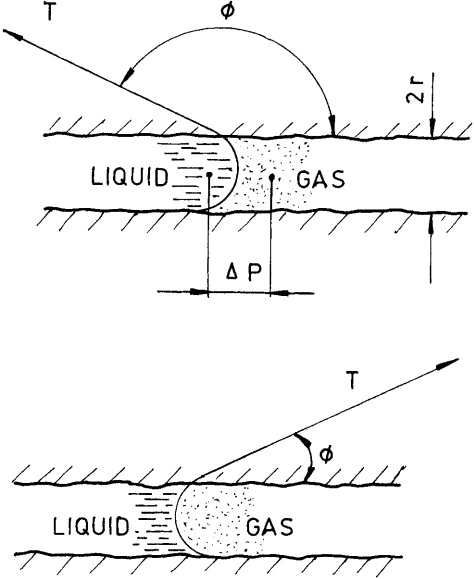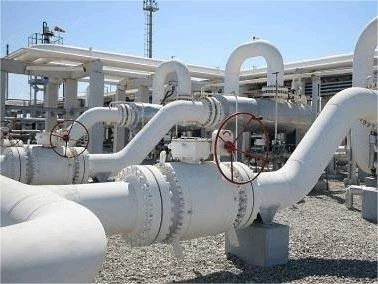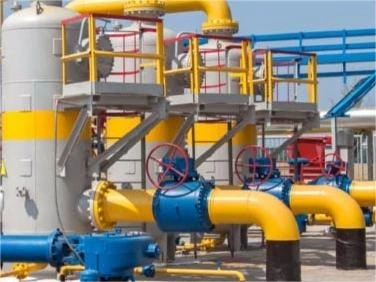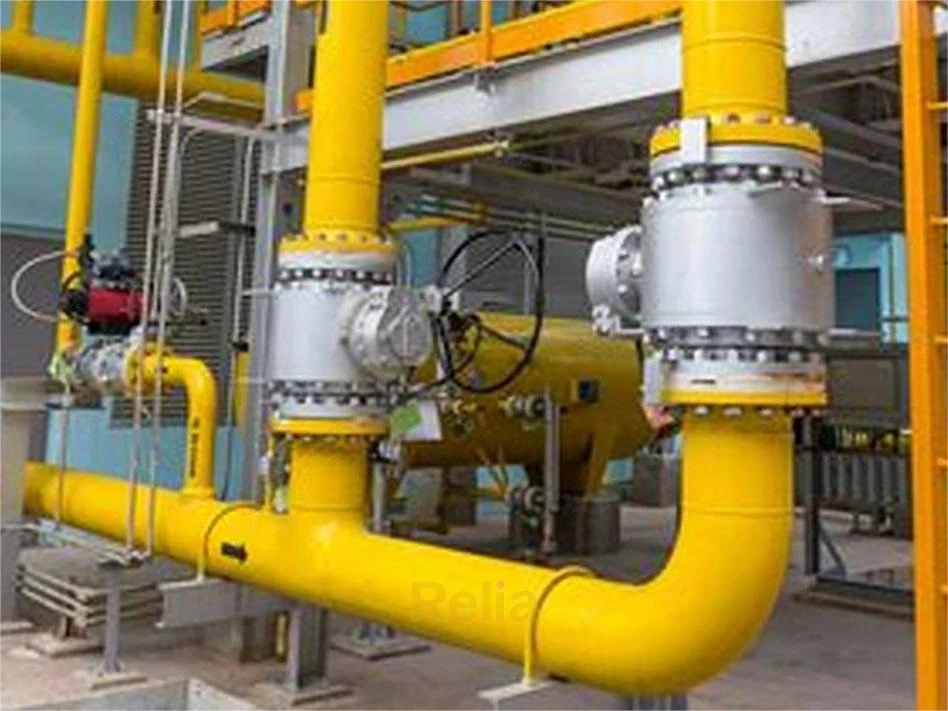Valve Sealing Mechanism
Sealability Against Liquids
The sealability against liquids is determined by the surface tension and the viscosity of the liquid.
When the leakage capillary is filled with gas, surface tension can either draw the liquid into the capillary or repel the liquid, depending on the angle of contact formed by the liquid with the capillary wall. The value of the contact angle is a measure of the degree of wetting of the solid by the liquid and is indicated by the relative strength of the attractive forces exerted by the capillary wall on the liquid molecules, compared with the attractive forces between the liquid molecules themselves.
Figure 2-2 illustrates the forces acting on the liquid in the capillary. The opposing forces are in equilibrium if
πr2 ΔP = 2πrT cos θ or ΔP = 2T cos θ/r
where
r = radius of capillary
ΔP = capillary pressure
T = surface tension
θ = contact angle between the solid and liquid
Thus, if the contact angle formed between the solid and liquid is greater than 90。, surface tension can prevent leakage flow. Conversely, if the contact angle is less than 90。, the liquid will draw into the capillaries and leakage flow will start at low pressures.
The tendency of metal surfaces to form a contact angle with the liquid of greater than 90。depends on the presence of a layer of oily, greasy, or waxy substances that normally cover metal surfaces. When this layer is removed by a solvent, the surface properties alter, and a liquid that previously was repelled may now wet the surface. For example, kerosene dissolves a greasy surface film, and a valve that originally was fluid-tight against water may leak badly after the seatings have been washed with kerosene. Wiping the seating surfaces with an ordinary cloth may be sufficient to restore the greasy film and, thus, the original seat tightness of the valve against water.

Figure 2-2. Effect of Surface Tension on Leakage Flow through Capillary.
Once the leakage capillaries are flooded, the capillary pressure becomes zero, unless gas bubbles carried by the fluid break the liquid column. If the diameter of the leakage capillary is large, and the Reynolds number of the leakage flow is higher than critical, the leakage flow is turbulent. As the diameter of the capillary decreases and the Reynolds number decreases below its critical value, the leakage flow becomes laminar. This leakage flow will, from Poisuille’s equation, vary inversely with the viscosity of the liquid and the length of the capillary and proportionally to the driving force and the diameter of the capillary. Thus, for conditions of high viscosity and small capillary size, the leakage flow can become so small that it reaches undetectable amounts.
Sealability Against Gases
The sealability against gases is determined by the viscosity of the gas and the size of the gas molecules. If the leakage capillary is large, the leakage flow will be turbulent. As the diameter of the capillary decreases and the Reynolds number decreases below its critical value, the leakage flow becomes laminar, and the leakage flow will, from Poisuille’s equation, vary inversely with the viscosity of the gas and the length of the capillary, and proportionally to the driving force and the diameter of the capillary. As the diameter of the capillary decreases still further until it is of the same order of magnitude as the free mean path of the gas molecules, the flow loses its mass character and becomes diffusive, that is, the gas molecules flow through the capillaries by random thermal motion. The size of the capillary may decrease finally below the molecular size of the gas, but even then, flow will not strictly cease, since gases are known to be capable of diffusing through solid metal walls.
Mechanism for Closing Leakage Passages
Machined surfaces have two components making up their texture: awavi- ness with a comparatively wide distance between peaks, and a roughness consisting of very small irregularities superimposed on the wavy pattern. Even for the finest surface finish, these irregularities are large compared with the size of a molecule.
If the material of one of the mating bodies has a high enough yield strain, the leakage passages formed by the surface irregularities can be closed by elastic deformation alone. Rubber, which has a yield strain of approximately 1, 000 times that of mild steel, provides a fluid tight seal without being stressed above its elastic limit. Most materials, however, have a considerably lower elastic strain, so the material must be stressed above its elastic limit to close the leakage passages.
If both surfaces are metallic, only the summits of the surface irregular- ities meet initially, and small loads are sufficient to deform the summits plastically. As the area of real contact grows, the deformation of the surface irregularities becomes plastic-elastic. When the gaps formed by the surface waviness are closed, only the surface roughness in the valleys remains. To close these remaining channels, very high loads must be applied that may cause severe plastic deformation of the underlying material. However, the intimate contact between the two faces needs to extend only along a continuous line or ribbon to produce a fluid-tight seal. Radially directed asperities are difficult or impossible to seal.


